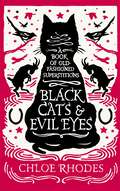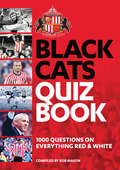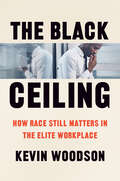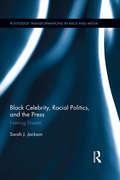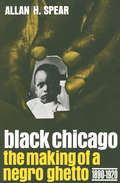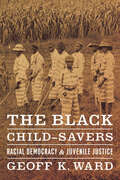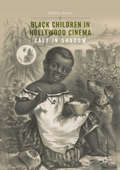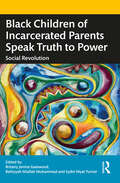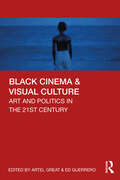- Table View
- List View
Black Cats and Evil Eyes: A Book of Old-Fashioned Superstitions
by Chloe RhodesThis collection investigates the origins of our most intriguing old-fashioned superstitions, many of which we still find ourselves abiding by today.Hundreds of the beliefs passed down through the generations have their foundations in our ancestors' efforts to ward off evil, which they blamed for hardship, illness and injustice in times when life was, as often as not, 'nasty, brutish and short'. Black Cats and Evil Eyes sets these superstitions in their historical and social context, explaining how fear of the Devil, demons, evil spirits and witchcraft drove people to arm themselves with rituals and talismans to repel dark forces and allow them to live long and healthy lives.In examining many of our common superstitions, this book illuminates the customs, beliefs and practices that link us to an ancient, and often darker, human past.
The Black Cats Quiz Book: 1,000 Questions on everything Red and White
by Rob MasonAre you an SAFC brain-box? If so, then put that claim to the test in the Black Cats Quiz Book. If not, well you’ll be well on the way to being one after having a bit of fun testing yourself and your friends. There are 100 quizzes and 1000 questions on all aspects of the red and whites, compiled by Sunderland AFC club historian Rob Mason. Right up to date with questions on the 2017-18 season, the quizzes kick-off with the traditional number one, goalkeepers, and finish with Super Kev - and he was a good finisher. The Black Cats Quiz Book covers the entire history of the club, ancient and modern. Full of fascinating facts and featuring the all-time greats as well as those of fleeting moments of fame, the Black Cats Quiz Book is something for you to dip into every now and then - but the chances are, you won’t be able to put it down as you see just how much of an SAFC brain-box you really are.
The Black Ceiling: How Race Still Matters in the Elite Workplace
by Kevin WoodsonA revelatory assessment of workplace inequality in high-status jobs that focuses on a new explanation for a pernicious problem: racial discomfort. America’s elite law firms, investment banks, and management consulting firms are known for grueling hours, low odds of promotion, and personnel practices that push out any employees who don’t advance. While most people who begin their careers in these institutions leave within several years, work there is especially difficult for Black professionals, who exit more quickly and receive far fewer promotions than their White counterparts, hitting a “Black ceiling.” Sociologist and law professor Kevin Woodson knows firsthand what life at a top law firm feels like as a Black man. Examining the experiences of more than one hundred Black professionals at prestigious firms, Woodson discovers that their biggest obstacle in the workplace isn’t explicit bias but racial discomfort, or the unease Black employees feel in workplaces that are steeped in Whiteness. He identifies two types of racial discomfort: social alienation, the isolation stemming from the cultural exclusion Black professionals experience in White spaces, and stigma anxiety, the trepidation they feel over the risk of discriminatory treatment. While racial discomfort is caused by America’s segregated social structures, it can exist even in the absence of racial discrimination, which highlights the inadequacy of the unconscious bias training now prevalent in corporate workplaces. Firms must do more than prevent discrimination, Woodson explains, outlining the steps that firms and Black professionals can take to ease racial discomfort. Offering a new perspective on a pressing social issue, The Black Ceiling is a vital resource for leaders at preeminent firms, Black professionals and students, managers within mostly White organizations, and anyone committed to cultivating diverse workplaces.
The Black Ceiling: How Race Still Matters in the Elite Workplace
by Kevin WoodsonA revelatory assessment of workplace inequality in high-status jobs that focuses on a new explanation for a pernicious problem: racial discomfort. America’s elite law firms, investment banks, and management consulting firms are known for grueling hours, low odds of promotion, and personnel practices that push out any employees who don’t advance. While most people who begin their careers in these institutions leave within several years, work there is especially difficult for Black professionals, who exit more quickly and receive far fewer promotions than their White counterparts, hitting a “Black ceiling.” Sociologist and law professor Kevin Woodson knows firsthand what life at a top law firm feels like as a Black man. Examining the experiences of more than one hundred Black professionals at prestigious firms, Woodson discovers that their biggest obstacle in the workplace isn’t explicit bias but racial discomfort, or the unease Black employees feel in workplaces that are steeped in Whiteness. He identifies two types of racial discomfort: social alienation, the isolation stemming from the cultural exclusion Black professionals experience in White spaces, and stigma anxiety, the trepidation they feel over the risk of discriminatory treatment. While racial discomfort is caused by America’s segregated social structures, it can exist even in the absence of racial discrimination, which highlights the inadequacy of the unconscious bias training now prevalent in corporate workplaces. Firms must do more than prevent discrimination, Woodson explains, outlining the steps that firms and Black professionals can take to ease racial discomfort. Offering a new perspective on a pressing social issue, The Black Ceiling is a vital resource for leaders at preeminent firms, Black professionals and students, managers within mostly White organizations, and anyone committed to cultivating diverse workplaces.
Black Celebrity, Racial Politics, and the Press: Framing Dissent (Routledge Transformations in Race and Media)
by Sarah J. JacksonShifting understandings and ongoing conversations about race, celebrity, and protest in the twenty-first century call for a closer examination of the evolution of dissent by black celebrities and their reception in the public sphere. This book focuses on the way the mainstream and black press have covered cases of controversial political dissent by African American celebrities from Paul Robeson to Kanye West. Jackson considers the following questions: 1) What unique agency is available to celebrities with racialized identities to present critiques of American culture? 2) How have journalists in both the mainstream and black press limited or facilitated this agency through framing? What does this say about the varying role of journalism in American racial politics? 3) How have framing trends regarding these figures shifted from the mid-twentieth century to the twenty-first century? Through a series of case studies that also includes Eartha Kitt, Sister Souljah, and Mahmoud Abdul-Rauf, Jackson illustrates the shifting public narratives and historical moments that both limit and enable African American celebrities in the wake of making public politicized statements that critique the accepted racial, economic, and military systems in the United States.
Black Celebrity, Racial Politics, and the Press: Framing Dissent (Routledge Transformations in Race and Media)
by Sarah J. JacksonShifting understandings and ongoing conversations about race, celebrity, and protest in the twenty-first century call for a closer examination of the evolution of dissent by black celebrities and their reception in the public sphere. This book focuses on the way the mainstream and black press have covered cases of controversial political dissent by African American celebrities from Paul Robeson to Kanye West. Jackson considers the following questions: 1) What unique agency is available to celebrities with racialized identities to present critiques of American culture? 2) How have journalists in both the mainstream and black press limited or facilitated this agency through framing? What does this say about the varying role of journalism in American racial politics? 3) How have framing trends regarding these figures shifted from the mid-twentieth century to the twenty-first century? Through a series of case studies that also includes Eartha Kitt, Sister Souljah, and Mahmoud Abdul-Rauf, Jackson illustrates the shifting public narratives and historical moments that both limit and enable African American celebrities in the wake of making public politicized statements that critique the accepted racial, economic, and military systems in the United States.
Black Chicago: The Making of a Negro Ghetto, 1890-1920
by Allan H. SpearAllan Spear explores here the history of a major Negro community during a crucial thirty-year period when a relatively fluid patter of race relations gave way to a rigid system of segregation and discrimination. This is the first historical study of the ghetto made famous by the sociological classics of St. Clair Drake, E. Franklin Frazier, and others—by the novels of Richard Wright, and by countless blues songs. It was this ghetto that Martin Luther King, Jr., chose to focus on when he turned attention to the racial injustices of the North. Spear, by his objective treatment of the results of white racism, gives an effective, timely reminder of the serious urban problems that are the legacy of prejudice.
Black Chicago: The Making of a Negro Ghetto, 1890-1920
by Allan H. SpearAllan Spear explores here the history of a major Negro community during a crucial thirty-year period when a relatively fluid patter of race relations gave way to a rigid system of segregation and discrimination. This is the first historical study of the ghetto made famous by the sociological classics of St. Clair Drake, E. Franklin Frazier, and others—by the novels of Richard Wright, and by countless blues songs. It was this ghetto that Martin Luther King, Jr., chose to focus on when he turned attention to the racial injustices of the North. Spear, by his objective treatment of the results of white racism, gives an effective, timely reminder of the serious urban problems that are the legacy of prejudice.
Black Chicago: The Making of a Negro Ghetto, 1890-1920
by Allan H. SpearAllan Spear explores here the history of a major Negro community during a crucial thirty-year period when a relatively fluid patter of race relations gave way to a rigid system of segregation and discrimination. This is the first historical study of the ghetto made famous by the sociological classics of St. Clair Drake, E. Franklin Frazier, and others—by the novels of Richard Wright, and by countless blues songs. It was this ghetto that Martin Luther King, Jr., chose to focus on when he turned attention to the racial injustices of the North. Spear, by his objective treatment of the results of white racism, gives an effective, timely reminder of the serious urban problems that are the legacy of prejudice.
Black Chicago: The Making of a Negro Ghetto, 1890-1920
by Allan H. SpearAllan Spear explores here the history of a major Negro community during a crucial thirty-year period when a relatively fluid patter of race relations gave way to a rigid system of segregation and discrimination. This is the first historical study of the ghetto made famous by the sociological classics of St. Clair Drake, E. Franklin Frazier, and others—by the novels of Richard Wright, and by countless blues songs. It was this ghetto that Martin Luther King, Jr., chose to focus on when he turned attention to the racial injustices of the North. Spear, by his objective treatment of the results of white racism, gives an effective, timely reminder of the serious urban problems that are the legacy of prejudice.
The Black Child-Savers: Racial Democracy and Juvenile Justice
by Geoff K. WardDuring the Progressive Era, a rehabilitative agenda took hold of American juvenile justice, materializing as a citizen-and-state-building project and mirroring the unequal racial politics of American democracy itself. Alongside this liberal "manufactory of citizens,” a parallel structure was enacted: a Jim Crow juvenile justice system that endured across the nation for most of the twentieth century. In The Black Child Savers, the first study of the rise and fall of Jim Crow juvenile justice, Geoff Ward examines the origins and organization of this separate and unequal juvenile justice system. Ward explores how generations of “black child-savers” mobilized to challenge the threat to black youth and community interests and how this struggle grew aligned with a wider civil rights movement, eventually forcing the formal integration of American juvenile justice. Ward’s book reveals nearly a century of struggle to build a more democratic model of juvenile justice—an effort that succeeded in part, but ultimately failed to deliver black youth and community to liberal rehabilitative ideals. At once an inspiring story about the shifting boundaries of race, citizenship, and democracy in America and a crucial look at the nature of racial inequality, The Black Child Savers is a stirring account of the stakes and meaning of social justice.
The Black Child-Savers: Racial Democracy and Juvenile Justice
by Geoff K. WardDuring the Progressive Era, a rehabilitative agenda took hold of American juvenile justice, materializing as a citizen-and-state-building project and mirroring the unequal racial politics of American democracy itself. Alongside this liberal "manufactory of citizens,” a parallel structure was enacted: a Jim Crow juvenile justice system that endured across the nation for most of the twentieth century. In The Black Child Savers, the first study of the rise and fall of Jim Crow juvenile justice, Geoff Ward examines the origins and organization of this separate and unequal juvenile justice system. Ward explores how generations of “black child-savers” mobilized to challenge the threat to black youth and community interests and how this struggle grew aligned with a wider civil rights movement, eventually forcing the formal integration of American juvenile justice. Ward’s book reveals nearly a century of struggle to build a more democratic model of juvenile justice—an effort that succeeded in part, but ultimately failed to deliver black youth and community to liberal rehabilitative ideals. At once an inspiring story about the shifting boundaries of race, citizenship, and democracy in America and a crucial look at the nature of racial inequality, The Black Child Savers is a stirring account of the stakes and meaning of social justice.
The Black Child-Savers: Racial Democracy and Juvenile Justice
by Geoff K. WardDuring the Progressive Era, a rehabilitative agenda took hold of American juvenile justice, materializing as a citizen-and-state-building project and mirroring the unequal racial politics of American democracy itself. Alongside this liberal "manufactory of citizens,” a parallel structure was enacted: a Jim Crow juvenile justice system that endured across the nation for most of the twentieth century. In The Black Child Savers, the first study of the rise and fall of Jim Crow juvenile justice, Geoff Ward examines the origins and organization of this separate and unequal juvenile justice system. Ward explores how generations of “black child-savers” mobilized to challenge the threat to black youth and community interests and how this struggle grew aligned with a wider civil rights movement, eventually forcing the formal integration of American juvenile justice. Ward’s book reveals nearly a century of struggle to build a more democratic model of juvenile justice—an effort that succeeded in part, but ultimately failed to deliver black youth and community to liberal rehabilitative ideals. At once an inspiring story about the shifting boundaries of race, citizenship, and democracy in America and a crucial look at the nature of racial inequality, The Black Child Savers is a stirring account of the stakes and meaning of social justice.
The Black Child-Savers: Racial Democracy and Juvenile Justice
by Geoff K. WardDuring the Progressive Era, a rehabilitative agenda took hold of American juvenile justice, materializing as a citizen-and-state-building project and mirroring the unequal racial politics of American democracy itself. Alongside this liberal "manufactory of citizens,” a parallel structure was enacted: a Jim Crow juvenile justice system that endured across the nation for most of the twentieth century. In The Black Child Savers, the first study of the rise and fall of Jim Crow juvenile justice, Geoff Ward examines the origins and organization of this separate and unequal juvenile justice system. Ward explores how generations of “black child-savers” mobilized to challenge the threat to black youth and community interests and how this struggle grew aligned with a wider civil rights movement, eventually forcing the formal integration of American juvenile justice. Ward’s book reveals nearly a century of struggle to build a more democratic model of juvenile justice—an effort that succeeded in part, but ultimately failed to deliver black youth and community to liberal rehabilitative ideals. At once an inspiring story about the shifting boundaries of race, citizenship, and democracy in America and a crucial look at the nature of racial inequality, The Black Child Savers is a stirring account of the stakes and meaning of social justice.
The Black Child-Savers: Racial Democracy and Juvenile Justice
by Geoff K. WardDuring the Progressive Era, a rehabilitative agenda took hold of American juvenile justice, materializing as a citizen-and-state-building project and mirroring the unequal racial politics of American democracy itself. Alongside this liberal "manufactory of citizens,” a parallel structure was enacted: a Jim Crow juvenile justice system that endured across the nation for most of the twentieth century. In The Black Child Savers, the first study of the rise and fall of Jim Crow juvenile justice, Geoff Ward examines the origins and organization of this separate and unequal juvenile justice system. Ward explores how generations of “black child-savers” mobilized to challenge the threat to black youth and community interests and how this struggle grew aligned with a wider civil rights movement, eventually forcing the formal integration of American juvenile justice. Ward’s book reveals nearly a century of struggle to build a more democratic model of juvenile justice—an effort that succeeded in part, but ultimately failed to deliver black youth and community to liberal rehabilitative ideals. At once an inspiring story about the shifting boundaries of race, citizenship, and democracy in America and a crucial look at the nature of racial inequality, The Black Child Savers is a stirring account of the stakes and meaning of social justice.
The Black Child-Savers: Racial Democracy and Juvenile Justice
by Geoff K. WardDuring the Progressive Era, a rehabilitative agenda took hold of American juvenile justice, materializing as a citizen-and-state-building project and mirroring the unequal racial politics of American democracy itself. Alongside this liberal "manufactory of citizens,” a parallel structure was enacted: a Jim Crow juvenile justice system that endured across the nation for most of the twentieth century. In The Black Child Savers, the first study of the rise and fall of Jim Crow juvenile justice, Geoff Ward examines the origins and organization of this separate and unequal juvenile justice system. Ward explores how generations of “black child-savers” mobilized to challenge the threat to black youth and community interests and how this struggle grew aligned with a wider civil rights movement, eventually forcing the formal integration of American juvenile justice. Ward’s book reveals nearly a century of struggle to build a more democratic model of juvenile justice—an effort that succeeded in part, but ultimately failed to deliver black youth and community to liberal rehabilitative ideals. At once an inspiring story about the shifting boundaries of race, citizenship, and democracy in America and a crucial look at the nature of racial inequality, The Black Child Savers is a stirring account of the stakes and meaning of social justice.
Black Children in Hollywood Cinema: Cast in Shadow
by Debbie OlsonThis book explores cultural conceptions of the child and the cinematic absence of black children from contemporary Hollywood film. Debbie Olson argues that within the discourse of children’s studies and film scholarship in relation to the conception of “the child,” there is often little to no distinction among children by race—the “child” is most often discussed as a universal entity, as the embodiment of all things not adult, not (sexually) corrupt. Discussions about children of color among scholars often take place within contexts such as crime, drugs, urbanization, poverty, or lack of education that tend to reinforce historically stereotypical beliefs about African Americans. Olson looks at historical conceptions of childhood within scholarly discourse, the child character in popular film and what space the black child (both African and African American) occupies within that ideal.
Black Children in Hollywood Cinema: Cast in Shadow
by Debbie OlsonThis book explores cultural conceptions of the child and the cinematic absence of black children from contemporary Hollywood film. Debbie Olson argues that within the discourse of children’s studies and film scholarship in relation to the conception of “the child,” there is often little to no distinction among children by race—the “child” is most often discussed as a universal entity, as the embodiment of all things not adult, not (sexually) corrupt. Discussions about children of color among scholars often take place within contexts such as crime, drugs, urbanization, poverty, or lack of education that tend to reinforce historically stereotypical beliefs about African Americans. Olson looks at historical conceptions of childhood within scholarly discourse, the child character in popular film and what space the black child (both African and African American) occupies within that ideal.
Black Children of Incarcerated Parents Speak Truth to Power: Social Revolution
by Britany Jenine Gatewood Bahiyyah Miallah Muhammad Sydni Myat TurnerThis book centers directly impacted Black children who have lived through parental incarceration. Their stories are told from holistic perspectives incorporating the full range of collateral consequences. Shifting from the Eurocentric and capitalistic viewpoint, they move us beyond negative outcomes to a positive prism by providing insider perspective, strategy, advice, and compelling experiences. We center Black children of incarcerated parents’ (BCOIP’s) rich narratives to show how they are conscious thinkers with perspectives that can help reimagine all Black children’s lives and futures. These stories help readers better understand the importance of exploring the revolutionary ways BCOIP continue to survive, thrive, and transform amid the dynamic challenges surrounding mass incarceration. The book shifts the social dialogue from fear of intergenerational crime and incarceration to resilience, success, Black joy, and self-love, and moves from sympathetic into an empathetic agenda. The book brings to the forefront counter-storytelling through oral narratives that fill a gap in literature that leaves out the voices of children of incarcerated parents who are doctors, lawyers, professional athletes, musicians, community leaders, activists, professors, teachers, bestselling authors, and much more. These are vital experiences to share because not all BCOIP will end up in prison, jail, or a detention center. Black Children of Incarcerated Parents Speak Truth to Power will be of great interest to scholars from the humanistic social sciences and humanities. It is also a timely resource for students (high school, undergraduate, and graduate) in sociology, criminology, corrections, humanities, social work, counseling, education, social justice, and related courses, as well as agency administrators, community organizations servicing families of the incarcerated, specifically incarcerated parents and the children of incarcerated parents, themselves.
Black Children of Incarcerated Parents Speak Truth to Power: Social Revolution
by Britany Jenine Gatewood Bahiyyah Miallah Muhammad Sydni Myat TurnerThis book centers directly impacted Black children who have lived through parental incarceration. Their stories are told from holistic perspectives incorporating the full range of collateral consequences. Shifting from the Eurocentric and capitalistic viewpoint, they move us beyond negative outcomes to a positive prism by providing insider perspective, strategy, advice, and compelling experiences. We center Black children of incarcerated parents’ (BCOIP’s) rich narratives to show how they are conscious thinkers with perspectives that can help reimagine all Black children’s lives and futures. These stories help readers better understand the importance of exploring the revolutionary ways BCOIP continue to survive, thrive, and transform amid the dynamic challenges surrounding mass incarceration. The book shifts the social dialogue from fear of intergenerational crime and incarceration to resilience, success, Black joy, and self-love, and moves from sympathetic into an empathetic agenda. The book brings to the forefront counter-storytelling through oral narratives that fill a gap in literature that leaves out the voices of children of incarcerated parents who are doctors, lawyers, professional athletes, musicians, community leaders, activists, professors, teachers, bestselling authors, and much more. These are vital experiences to share because not all BCOIP will end up in prison, jail, or a detention center. Black Children of Incarcerated Parents Speak Truth to Power will be of great interest to scholars from the humanistic social sciences and humanities. It is also a timely resource for students (high school, undergraduate, and graduate) in sociology, criminology, corrections, humanities, social work, counseling, education, social justice, and related courses, as well as agency administrators, community organizations servicing families of the incarcerated, specifically incarcerated parents and the children of incarcerated parents, themselves.
The Black Church Studies Reader
by Carol B. Duncan Alton B. PollardThe Black Church Studies Reader addresses the depth and breadth of Black theological studies, from Biblical studies and ethics to homiletics and pastoral care. The book examines salient themes of social and religious significance such as gender, sexuality, race, social class, health care, and public policy. While the volume centers around African American experiences and studies, it also attends to broader African continental and Diasporan religious contexts. The contributors reflect an interdisciplinary blend of Black Church Studies scholars and practitioners from across the country. The text seeks to address the following fundamental questions: What constitutes Black Church Studies as a discipline or field of study? What is the significance of Black Church Studies for theological education? What is the relationship between Black Church Studies and the broader academic study of Black religions? What is the relationship between Black Church Studies and local congregations (as well as other faith-based entities)? The book's search for the answers to these questions is compelling and illuminating.
Black Cinema & Visual Culture: Art and Politics in the 21st Century
by Artel Great Ed GuerreroThis culturally and politically timely collection examines new Black films and moving images that have, once again, excited and possibly shifted the global media landscape. At a moment some scholars have described as post-post-racial, Black Cinema & Visual Culture provides new, urgent definitions and theories for Black cinema and furthers the development of its critical discourses. Gathering some of the leading scholars and critics in the field, this book enriches and advances the study of Black film and media and its social and political implications at a breakthrough period of expansion in the 21st century. This anthology tackles a wide range of topics from social justice, new media, and Afrofuturism, to race, gender, sexuality, mass incarceration, cultural memory, and Afrosurrealism, exploring the current climate of Black cinematic art that has proven wildly popular with domestic and global audiences, including hit films like Get Out and Marvel’s Black Panther. Together, these essays deepen understandings of Black visual culture, its creative image-makers, the political economy of Hollywood, and the cultural politics at the intersection of modern cinema, streaming platforms, and digital technologies. Black Cinema & Visual Culture will serve as an important learning tool for university courses spanning topics in film studies, American film and television, cultural studies, American studies, African Diaspora studies, media activism, social analysis, and African-American studies. This volume will also provide a benchmark in popular and intellectual circles for anyone interested in popular culture, Black-American cinema, media, issues of race in Hollywood, or Black culture and the conditions that shape both its art and politics.
Black Cinema & Visual Culture: Art and Politics in the 21st Century
by Artel Great Ed GuerreroThis culturally and politically timely collection examines new Black films and moving images that have, once again, excited and possibly shifted the global media landscape. At a moment some scholars have described as post-post-racial, Black Cinema & Visual Culture provides new, urgent definitions and theories for Black cinema and furthers the development of its critical discourses. Gathering some of the leading scholars and critics in the field, this book enriches and advances the study of Black film and media and its social and political implications at a breakthrough period of expansion in the 21st century. This anthology tackles a wide range of topics from social justice, new media, and Afrofuturism, to race, gender, sexuality, mass incarceration, cultural memory, and Afrosurrealism, exploring the current climate of Black cinematic art that has proven wildly popular with domestic and global audiences, including hit films like Get Out and Marvel’s Black Panther. Together, these essays deepen understandings of Black visual culture, its creative image-makers, the political economy of Hollywood, and the cultural politics at the intersection of modern cinema, streaming platforms, and digital technologies. Black Cinema & Visual Culture will serve as an important learning tool for university courses spanning topics in film studies, American film and television, cultural studies, American studies, African Diaspora studies, media activism, social analysis, and African-American studies. This volume will also provide a benchmark in popular and intellectual circles for anyone interested in popular culture, Black-American cinema, media, issues of race in Hollywood, or Black culture and the conditions that shape both its art and politics.
The Black Circuit: Race, Performance, and Spectatorship in Black Popular Theatre (Sociology Re-Wired)
by Rashida Z. McMahonThe Black Circuit: Race, Performance, and Spectatorship in Black Popular Theatre presents the first book-length study of Chitlin Circuit theatre, the most popular and controversial form of Black theatre to exist outside the purview of Broadway since the 1980s. Through historical and sociological research, Rashida Z. Shaw McMahon links the fraught racial histories in American slave plantations and early African American cuisine to the performance sites of nineteenth-century minstrelsy, early-twentieth-century vaudeville, and mid-twentieth-century gospel musicals. The Black Circuit traces this rise of a Black theatrical popular culture that exemplifies W. E. B. Du Bois’s 1926 parameters of "for us, near us, by us, and about us," with critical differences that, McMahon argues, complicate our understanding of performance and spectatorship in African American theatre. McMahon shows how an integrated and evolving network of consumerism, culture, circulation, exchange, ideologies, and meaning making has emerged in the performance environments of Chitlin Circuit theatre that is reflective of the broader influences at play in acts of minority spectatorship. She labels this network the Black Circuit.
The Black Circuit: Race, Performance, and Spectatorship in Black Popular Theatre (Sociology Re-Wired)
by Rashida Z. McMahonThe Black Circuit: Race, Performance, and Spectatorship in Black Popular Theatre presents the first book-length study of Chitlin Circuit theatre, the most popular and controversial form of Black theatre to exist outside the purview of Broadway since the 1980s. Through historical and sociological research, Rashida Z. Shaw McMahon links the fraught racial histories in American slave plantations and early African American cuisine to the performance sites of nineteenth-century minstrelsy, early-twentieth-century vaudeville, and mid-twentieth-century gospel musicals. The Black Circuit traces this rise of a Black theatrical popular culture that exemplifies W. E. B. Du Bois’s 1926 parameters of "for us, near us, by us, and about us," with critical differences that, McMahon argues, complicate our understanding of performance and spectatorship in African American theatre. McMahon shows how an integrated and evolving network of consumerism, culture, circulation, exchange, ideologies, and meaning making has emerged in the performance environments of Chitlin Circuit theatre that is reflective of the broader influences at play in acts of minority spectatorship. She labels this network the Black Circuit.
